Saving the Night Sky
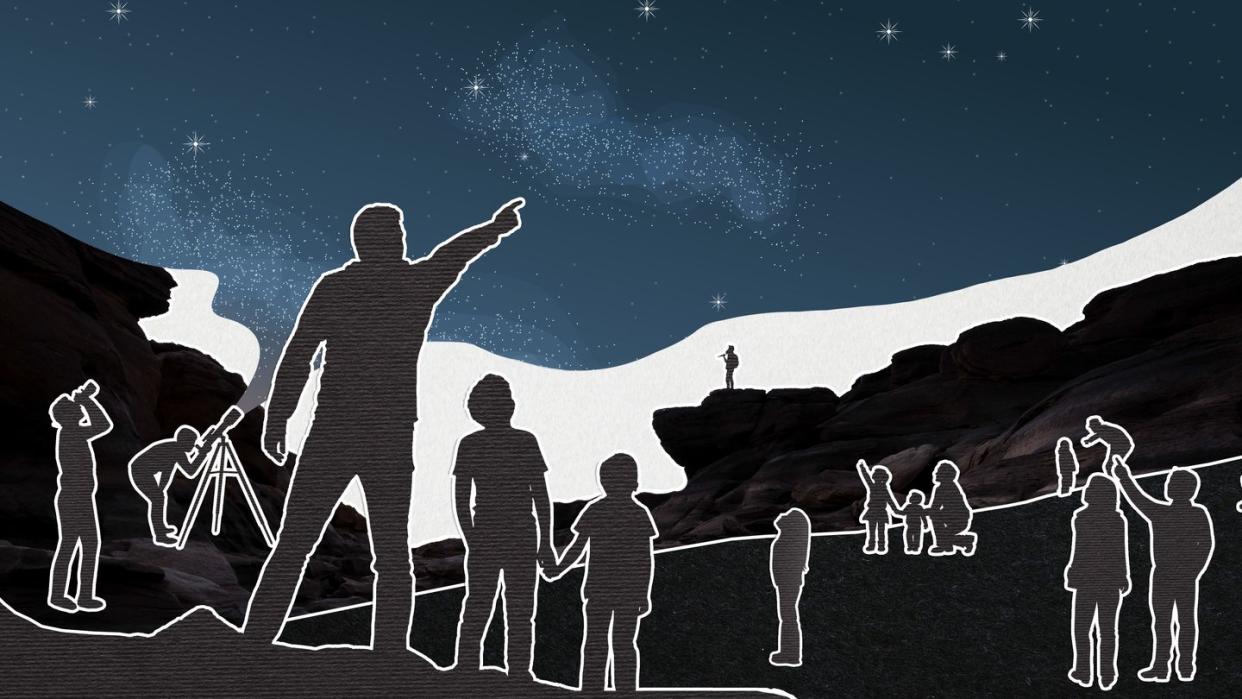
On a Saturday night in late April, I set out with a pair of binoculars for the eastern spur of the Point Reyes Headlands. I have driven this route countless times, but rarely at night. Mice, illuminated in the double beam of my headlights, shoot across the road. A coyote trots through a cow pasture. A badger stares me down, then sinks back into the ground. The park is alive at night, when the humans are away. But terrestrial sightings aren’t what I’m after. It’s the weekend of the Lyrid meteor shower, and I seek complete darkness.
I’ll be honest: I’ve probably spent more time watching the Dallas Stars than the actual stars, and I’m not even a Stars fan. But like a lot of my neighbors here in Point Reyes, California, I’ve started looking up more often, thanks to a local effort to certify the western portion of Marin County as a Dark Sky Reserve (land with an exceptional quality of starry nights that’s protected for its scientific, natural, educational, or cultural value). If the effort is successful, Point Reyes would become only the third Dark Sky Reserve in the United States, after the Greater Big Bend and Central Idaho Dark Sky Reserves, and the closest to a major city.
Still, as heartening as it was to learn that my community cared about the night sky, I was unsure what exactly it meant to preserve it, and why we’d prioritize the issue. Of all the problems this small town faces—drought, wildfires, a housing shortage—how did we come to devote our collective energy to the night sky?
It all began with a complaint. In 2020, the Point Reyes Station Village Association, an organization dedicated to preserving the rural nature of the town, started to field an increasing number of reports about lights keeping people awake at night. In response, Peggy Day, then the Secretary of the Village Association, formed a committee to identify lighting that did not conform to the town’s community plan.
Before I go any further on this journey into local politics, let me pause to say that I understand how some people might hear the words “complaint” and “community plan” and roll their eyes at this whole situation. Honestly, if I were on the board, I probably would’ve asked the neighbors to sort the problem out themselves. With everything going on in the world in 2020, who had the energy to worry about a few light bulbs? But these initial complaints were the seeds for something larger.
“Outdoor lighting shall serve the safety of ingress and egress,” the plan reads, “but shall not detract from the enjoyment of the natural nightscape.” This language aligns with guidance on outdoor lighting provided by the International Dark-Sky Association (IDA), which certifies areas as Dark Sky places. No one’s telling you to turn off the lights completely—only to be thoughtful about how you use light.
In Fall 2020, not long after Point Reyes locals began walking through town at night to identify disruptive lighting, Laura Arndt, Day’s colleague at the Village Association, reached out to the leaders of the Dark Sky communities of Borrego Springs and Julian, in San Diego County. Arndt, who grew up in Southern California, was familiar with the towns’ efforts to protect the night sky outside of the Anza-Borrego Desert State Park. In her interviews, she found that Point Reyes shares many characteristics with Borrego Springs and Julian, also small towns on the edge of protected land with a lot of community pride. A Dark Sky initiative in Point Reyes sounded possible. At the next monthly meeting, Arndt introduced the idea of Dark Sky certification to the Village Association and, with Day, reached out to Marin County Supervisor Dennis Rodoni to see if a Dark Sky designation was feasible for Point Reyes Station. Word spread quickly, thanks in part to an article published in January 2021 in the local newspaper, the Point Reyes Light.
The National Seashore, it turned out, was also interested in addressing its light pollution. Christine Beekman, Information Officer at the National Seashore, approached the Village Association about a potential collaboration between the small town and the park. With the National Seashore involved, it was possible to pursue status not just as a Dark Sky community—legally organized cities and towns dedicated to protecting the night sky, such as Borrego Springs and Julian—but as a Dark Sky Reserve, which consists of two regions: “a core area that meets minimum criteria for sky quality and natural darkness,” such as the ability to see the Milky Way with the unaided eye, and a peripheral zone “that supports dark-sky values.” In that zone, 80% of lighting must meet dark-sky standards. The park and the town agreed to file joint applications, with the National Seashore as the core area and Point Reyes Station and surrounding villages as the periphery, and thus the Dark Sky Point Reyes Initiative was formed.
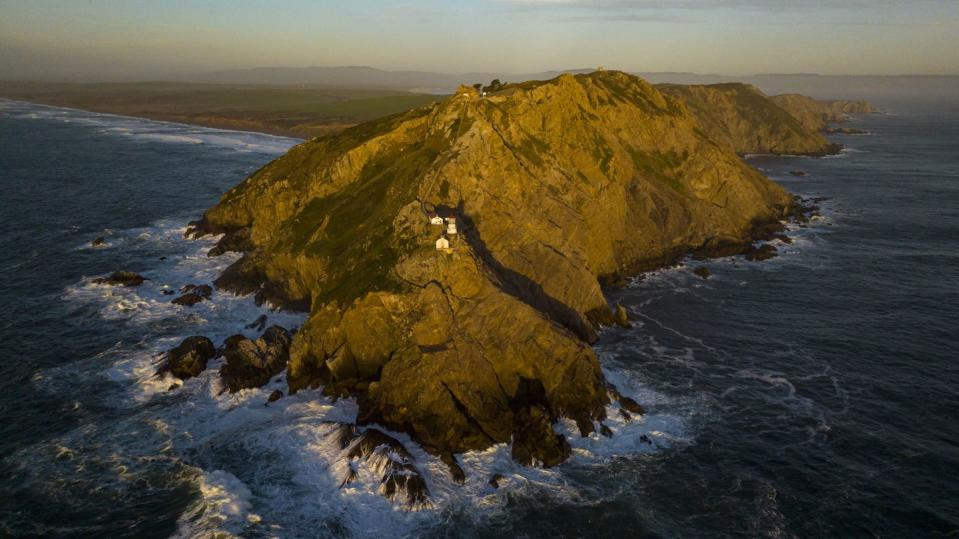
Compared to ChatGPT, the latest technology whose potential impact on the world we’re scrambling to manage, the lightbulb is ancient. But in our planet’s 4.5-billion-year history, electrification is a relatively new phenomenon. Snapshots of Earth at night from the late 1950s to today show an increasingly brighter planet. “This makes sense,” I thought when I first saw the satellite images—today there are over 5 billion more people in the world! I imagined all the lightbulbs in all the streetlamps outside all the homes in all the towns built since the 1950s. That had to be a lot. But according to the IDA, light pollution—the inappropriate or excessive use of artificial light—is increasing worldwide at twice the rate of global population growth. “More people [use] more light,” Paul Bogard, the author of The End of Night, told me. Take gas stations, for instance. “About twenty years ago in America,” Bogard writes, “gas stations began to increase the level of lighting, not for any real safety concerns but for marketing purposes.”
Are we really erasing our view of the night sky for such mundane reasons? The answer, apparently, is yes. “The fact is that much outdoor lighting used at night is inefficient, overly bright, poorly targeted, improperly shielded, and, in many cases, completely unnecessary,” reads the IDA’s website. “This light, and the electricity used to create it, is being wasted by spilling it into the sky, rather than focusing it on to the actual objects and areas that people want illuminated.”
Light pollution can have serious environmental consequences for humans—it can disrupt our circadian rhythm, for starters—but some of the most concrete examples of its impact come from its effects on wildlife. The beams of light we shoot up into the night sky in Las Vegas and New York attract birds and insects to their deaths. Baby sea turtles, attempting to detect the bright horizon over the ocean, make their way instead in the opposite direction, across roads to brightly lit beachfront condos. Glare disrupts the nocturnal activity of frogs and toads, interfering with reproduction. I could go on. I have a whole pamphlet on this.
I picked up the pamphlet at the Dark Sky Point Reyes Initiative’s inaugural public meeting, which I attended a few days before the meteor shower, at the Dance Palace community center in Point Reyes Station. I wanted to find out who else was interested in this initiative, and what had motivated them to come out on a weeknight to rally around saving the night sky, or perhaps even to speak out against the stars.
When I entered, a few dozen people were gathered inside. A snack table featured brownies with star sprinkles and bite-sized star-shaped sandwiches. At 38 years old, I was among the youngest in the crowd. I did the mental math and thought about how most of the people in that room had been born around the time of the photo from space taken in the 1950s, or even before. Were these people resistant to change, hopelessly clinging to a less electrified past?
I tallied in the audience amateur astronomers, homeowners, a representative from the National Seashore, small business owners, local politicians, and a lighting expert who impressed everyone when he revealed that what we think of as “cool” and “warm” colors is a misnomer. (Blue is hot!)
It wasn’t tough to strike up a conversation. Everyone wanted to talk about the stars. Did you know that 80% of Americans are unable to see the Milky Way from where they live? And that for every 250 stars you see today, you will only be able to see 100 from that same spot in eighteen years if light pollution trends continue? Even a bright asterism like Orion’s Belt will disappear.
Nobody used the stars to argue for or against other hot-button local issues, like proposed development in the area or the recently renewed leases to ranchers on public land. Even the county supervisor described the Dark Sky Initiative as “noncontroversial.”
I loitered after the meeting, hoping to catch someone with concerns. A woman behind a table on which multiple pamphlets on light pollution were up for grabs—Light Pollution Can Harm Wildlife; Light Pollution Wastes Energy and Money; Light Pollution Can Put Your Health at Risk; Outdoor Lighting, Crime, and Safety—made eye contact with me. I expected a lecture on the various talking points outlined in her pamphlets. But instead she asked me if I’d been out to observe the night sky with local stargazer Don Jolley. I had not, I told her. You must, she said.
Don Jolley taught middle schoolers in the area for over thirty years. He now considers himself semi-retired, but leads stargazing events every month on the outskirts of town, in the wetlands near the old white barn. He’s a charismatic speaker; Day described him as “hypnotic.” When I called him up, we talked about starbathing and drawing the night sky by hand and what it means to realize that the blue jay outside your window isn’t just another blue jay, but the same one that visited you yesterday, and the one you will see tomorrow, too, if you’re lucky. I was transfixed. In the space of twenty minutes, Jolley had worked his magic on me. But when I asked why he suspects people join him at night, oftentimes in the cold, to look up at the stars, he had to think for a minute. “Maybe it’s the sense that something’s missing,” he said. “And yet it’s not that far away. It’s something really accessible. It’s right there.”
Of all the climate problems we face, light pollution is among the easiest to fix. All we have to do is dim a few lights! That feels eminently achievable in comparison to, say, removing microplastics from the ocean. But even in an environmentally-friendly area like Point Reyes, there are still obstacles to overcome.
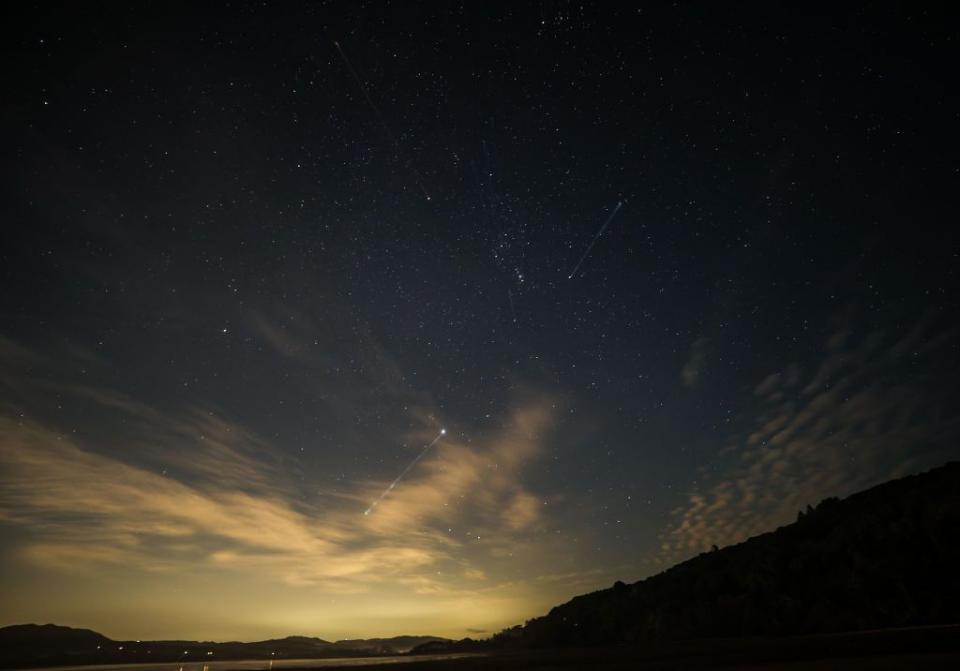
Day, who now co-leads the Dark Sky Point Reyes Initiative along with Arndt, took me on a walk around town to show me what improvements have and have not been made to mitigate light pollution. I’ve lived near the town for almost three years now, and for a decade before I moved here, I visited on weekends after a surf or a hike or a camping trip. But this tour made me look at the place differently. Day showed me how some lights are shielded. Some, they’re still working on. There’s red tape to deal with at places like the school and the bank. Yes, red tape even for something as simple as turning off or shielding a light. I guess there are security concerns, though any Dark Sky advocate will help dispel misconceptions about lighting and safety. (I have a pamphlet!)
I was grateful that Day was volunteering her time for sorting through the bureaucracy. I love the night sky, but I loathe bureaucracy. A friend joked recently about who gets to publish those 600-page doorstopper novels where nothing happens and asked what mine would be. I wasn’t sure, but now I know it would be a 600-page psychological horror whose immediate action involves a person walking from one side of the room to the other to dim the lights, only to be interrupted by several ridiculously tedious obstacles. Convincing Wells Fargo to reduce light pollution sounds a lot like that.
As I walked with Day, I thought about how this all started with a complaint. That word, “complaint,” comes with the “can I speak to the manager?” energy that can easily trigger eye-rolls. But its root comes from the Anglo-French compleindre, “to lament,” a passionate expression of grief or sorrow. The residents of Point Reyes Station only wanted a good night’s sleep. Blackout curtains might have done the trick. But lack of sleep was a symptom of a larger problem in a town that has changed considerably since that photo taken from space in the late 1950s. “[N]urturing change while preserving [the town’s] culture requires care and diligence,” reads the Village Association’s website. As I learned more about the Dark Sky Initiative, I came to see its advocates not as resistant to change, as I’d initially assumed, but as a group of people dedicated to preserving the shared values of a community, who understood the gift of night and wanted to volunteer their time to pass it along. In this context, the complaints about bright lights might be heard as the lamentations of a town on the precipice of change—an expression of grief for what we might lose.
Day and I walked a block off the main street to the Livery Stable, a building that houses the local gym and a store called Visions where I once bought a bumper sticker that says I’d Rather Be Here Now. The owner of the building, unable to find shields that fit his lights, made his own out of heavy-duty black tape from the hardware store up the block. A solution could be that simple.
Almost every time I’ve visited the eastern spur of the Point Reyes Headlands during the day, usually around sunrise or sunset, someone else is there. But tonight, the parking lot is empty. I wonder how much longer it will be like this. Probably not too long: if preserving the night sky means raising awareness, more people like me, eager amateur stargazers, will make the trek out to dark places. Already my burgeoning interest in the night sky has led to several Google searches, so now, all my targeted ads are for astrotourism. Did you know you can take a stargazing train through Nevada? Or rent out an observatory in Colorado for a private star party?
Parked, I hop out of my car and walk towards the elephant seal overlook. That’s the spot where 80% of the night sky is visible, according to data Christine Beekman of the National Seashore cited at the community meeting. A significant number. Even in Muir Woods, a striking forest of redwoods on Mt. Tamalpais, visibility is only 24%. That’s because Muir Woods is closer to the main sources of light pollution that also impact Point Reyes: the towns along the Highway 101 corridor and the San Francisco metro area.
San Francisco, about forty miles south, emits a glow I can see as I continue my walk to the elephant seal overlook. That glow reminds me of the proximity of this rural town to a city I’ve called home at various points in the last fifteen years, a city filled with friends and bookstores and bakeries. A city that’s also the birthplace of inventions that have had a direct impact on the rural nature of this area. Trails that were once known only through word of mouth now appear on Strava maps. A tunnel of cypress trees and a shipwrecked fishing boat are Instagram-famous. Despite the area’s housing shortage, so many homes were converted to Airbnbs that the county declared a temporary moratorium on new short-term rentals. App pollution, you might call it.
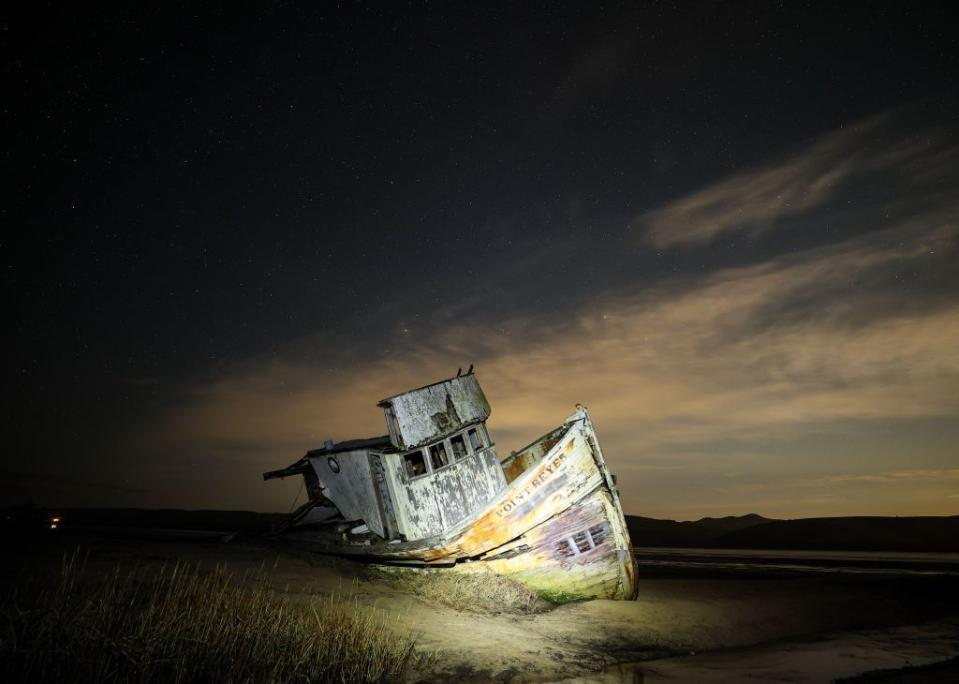
Full disclosure: I use all of the apps mentioned above, and even worked for one. I’m not against technology. I know as many people who don’t use smartphone apps as I do people who don’t use lightbulbs, which is to say: none. Conversations about the impact of technologies are more complex than whether we should use them or not. The Dark Sky approach to light might be a good starting point. Understand when you need it and when you don’t, and come together to figure out collectively how to manage that.
Once at the overlook, I turn my iPhone flashlight off and let my eyes adjust. It takes a few minutes, but then the night fills with stars. I gaze up, and it isn’t long before a meteor streaks across the sky. But the astrological object I’m most eager to spot, I’m embarrassed to admit, is not a meteor—it’s a line of Starlink satellites. When I heard about the local effort to preserve the night sky, the SpaceX constellations came to mind immediately. I pictured a group of well-meaning Marinites trekking into the wetlands outside of town and staring up at the heavens, only to see a line of Elon Musk’s satellites pass by. What does it mean to preserve the night sky when anyone can alter it?
Christopher Cokinos, a science writer and the author of the forthcoming book Still as Bright: An Illuminating History of the Moon from Antiquity to Tomorrow, told me he’d seen a Starlink constellation while stargazing in northern Utah. “It was this kinetic futurist sculpture in the sky,” Cokinos said. “They were very bright. There was no mistaking it. So my reaction was, ‘That’s gorgeous and beautiful and we probably shouldn’t have them flying over everywhere all the time.’” We talked about Starlink’s light pollution, its impact on astronomy, and the recent lawsuit brought forth by environmental groups against the FAA over SpaceX’s launch of its Starship rocket earlier this year. Satellites and space debris reflect and scatter sunlight, which makes the night sky brighter for everyone, whether you’re in a city or a Dark Sky Reserve. This, in turn, interferes with astronomical observations. Cokinos emphasized that SpaceX and companies like it need to take community input seriously. “I think in a way the community of Point Reyes coming together to establish these local standards the best they can is a kind of acknowledgement that companies like SpaceX… need to pay attention to. Which is that communities are here. They matter.”
At the end of our walk through town, Day led me to the fire station, recently outfitted with Dark Sky-friendly lighting. After inquiring about the lights, she thanked the firemen for saving her life a year and a half ago when she suffered a heart attack. She told me later that during her recovery, she needed to resign her role in the Village Association, but wanted to continue volunteering her time to the Dark Sky Initiative. “It’s so positive,” she said. “Everyone comes together.”
At this remark, I was transported back to the community meeting a few weeks prior, when Day introduced each guest speaker with an honorary cosmic title: the local astronomer was “our North Star”; a colleague at the Village Association, Venus; a county politician, Mercury. The rest of us in the audience might have been other stars and planets, finally coming into focus. Together, we were a galaxy, clearly visible.
Like all forms of pollution, light pollution can’t be contained: what our neighbors do matters. If a street light shines into our bedroom window, we won’t sleep. If cities become brighter, so too do surrounding towns. If SpaceX ignores the feedback of astronomers, our night sky will be vastly altered. Put this way, it can all seem overwhelming. Like the main character in my hypothetical doorstopper novel, we might begin to feel helpless and wonder, “What’s the point?”
But the Dark Sky Point Reyes Initiative gives me hope—not because I imagine everyone will return home from Point Reyes inspired to turn their own town into a Dark Sky community, or to lobby the owners of skyscrapers to participate in Audubon’s Lights Out program for migratory birds. It gives me hope because those initial complaints about bright lights weren’t brushed off. People listened. They looked out for one other. A community came together.
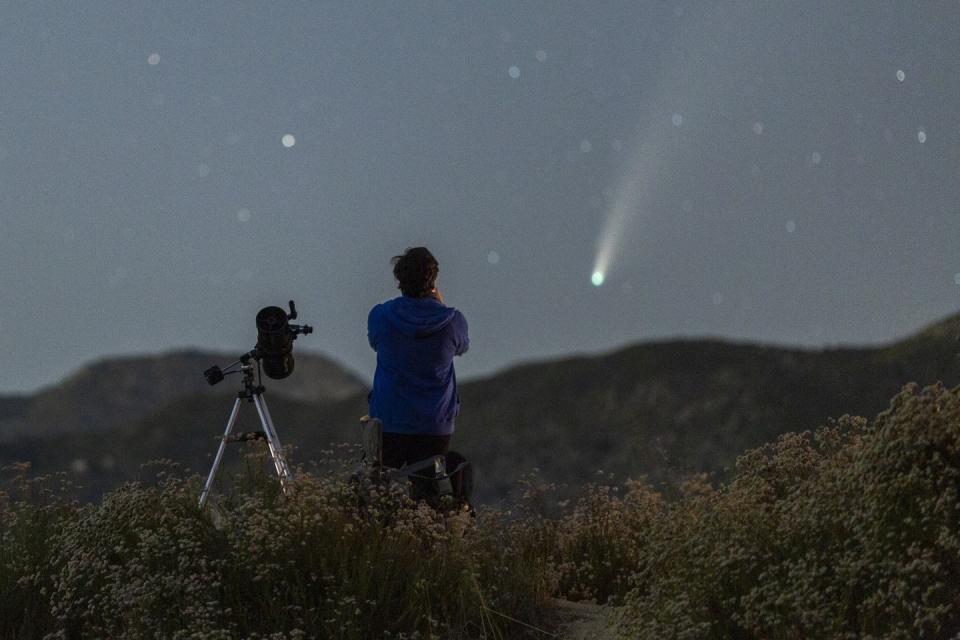
Point Reyes is a community on the precipice of change, but couldn’t we say the same about every place on this planet? In Montana, sixteen young people have filed a lawsuit that claims their home state isn’t doing enough to address climate change. The state Constitution explicitly says that citizens have “the right to a clean and healthful environment.” Still, State Attorney General Austin Knudsen’s office “has made several attempts to get the youth climate lawsuit thrown out,” Montana Public Radio reports, “but has so far failed.” Knudsen hears the complaint from his neighbors, but unlike the people of Point Reyes, he isn’t listening. He doesn’t even offer black-out curtains. He just flat-out refuses to believe the streetlight exists.
“A federal judge in Oregon said she’ll hear an amended version of a similar federal lawsuit that was previously thrown out,” the Montana Public Radio article continues, more optimistically. “That suit was filed in 2015 by a group of 21 kids from around the country.” Eight years later, the complaint will be considered. Still, the Climate Clock ticks.
Just before this essay was published, Day called me with an important update: the National Seashore needs to delay the Dark Sky application process for budgetary reasons. Day and the Village Association, however, don’t want to wait. The result? The villages, operating under the new name of Dark Sky West Marin, will seek designation as a Dark Sky Community; the National Seashore, when it’s ready, will seek designation as a Dark Sky Park. The ultimate goal is still to become a Dark Sky Reserve—it just might take a little longer.
I was a little disheartened to hear this. The ambition to seek Reserve status right out of the gate is what drew me to the initiative in the first place. When I asked Day why the villages won’t wait to file with the Seashore, she emphasized the importance of sustained momentum. “A [loss of] momentum can make a project not happen,” she told me. “And I’m old. I don’t know if I’m going to be alive to see this. I don’t want to wait another year.”
Jolley, the local stargazer, believes that everyone can have what he calls their own “Copernican moment,” where it sinks in that it’s not the stars moving, but you. “Once you have that moment, you never go back.”
I planned to head out to stargaze with Jolley and Day and others this month, but clouds and fog thwarted our plans. The night sky was hidden, and I noticed.
You Might Also Like

